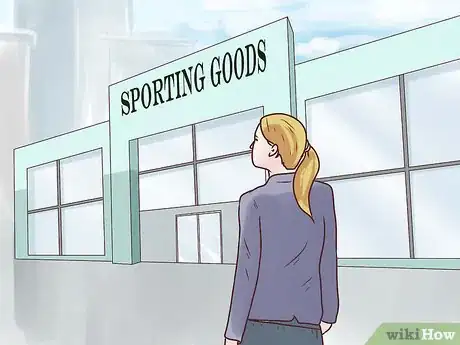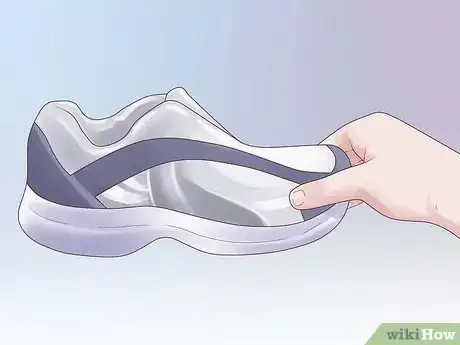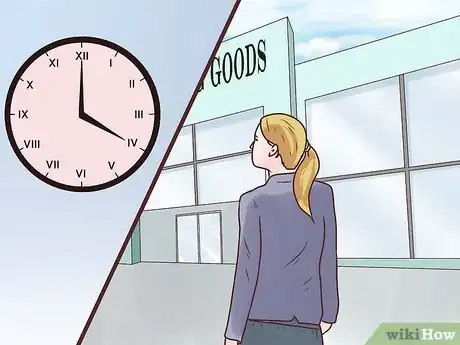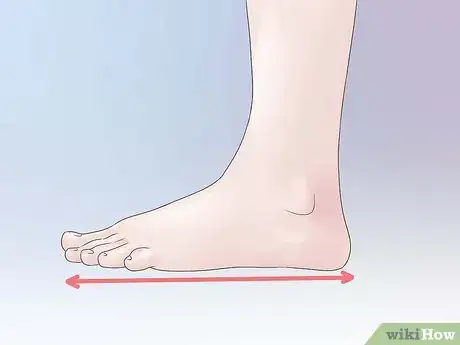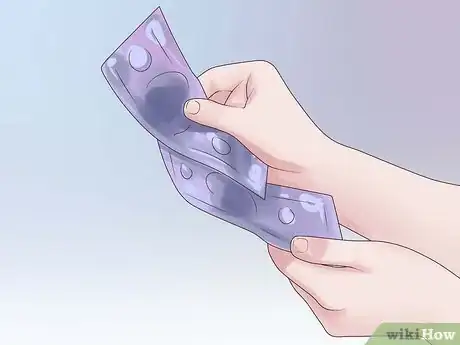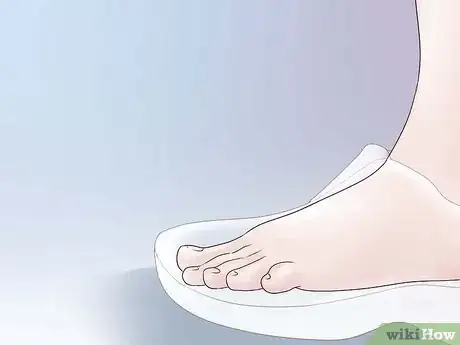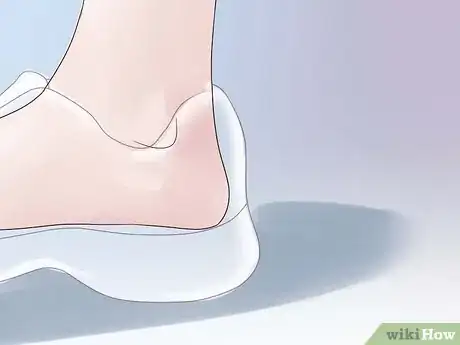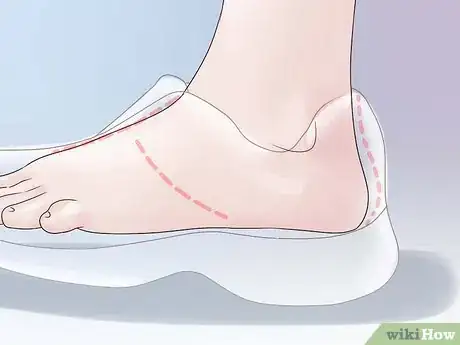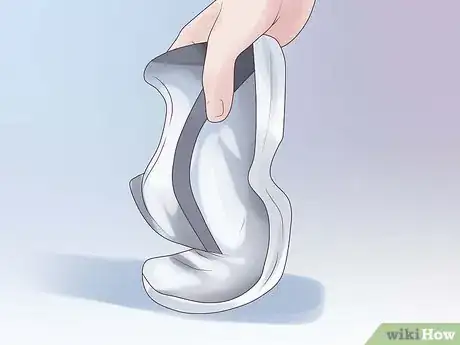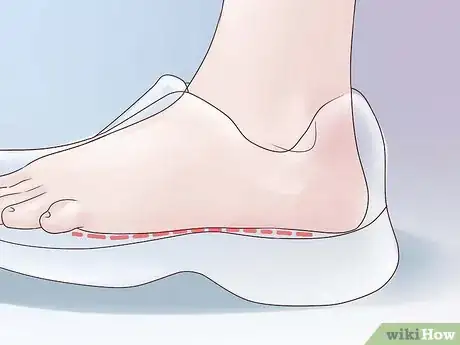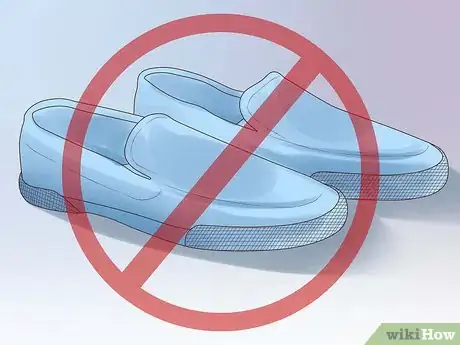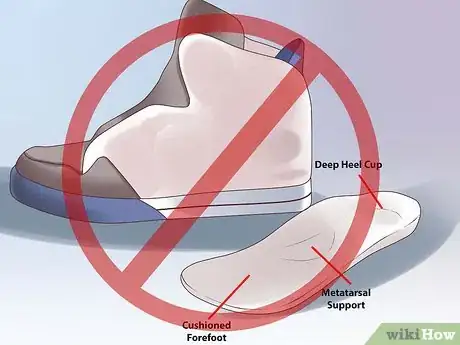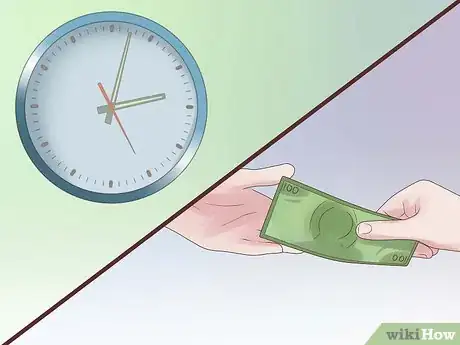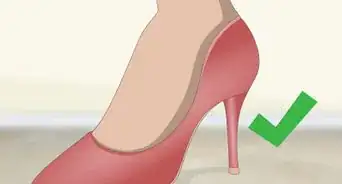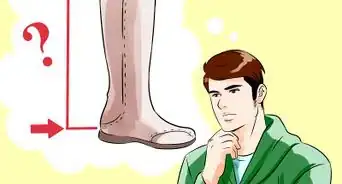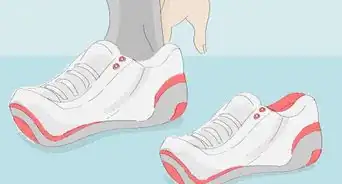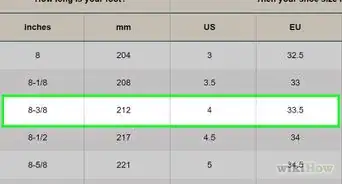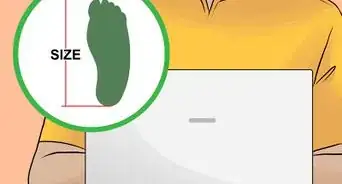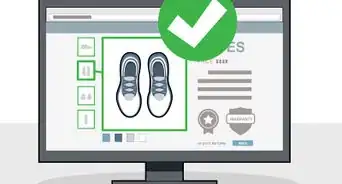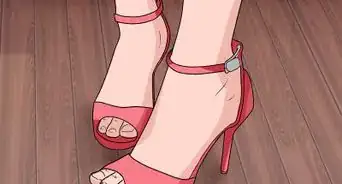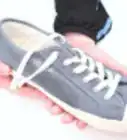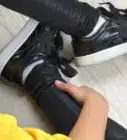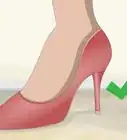This article was co-authored by Kai Ng. Kai Ng is a USATF and RRCA Certified Running Coach at Run Coach Kai. Kai has competed in over 55 races and over 15 marathons, and has trained with 16x USA and World record holder Patti Catalano Dillonso. He specializes in coaching runners of all levels and showing people that everyone can be a runner. Kai is committed to helping his clients reach their goals by showing them how to run with proper form and holding them accountable to train consistently.
There are 11 references cited in this article, which can be found at the bottom of the page.
This article has been viewed 49,486 times.
Running shoes can have a huge impact on how comfortable you feel while running, whether you're jogging around your local track, trail running through a forest or competing in a marathon. The right pair can also help you to avoid accidents and injuries, while the wrong pair can actually increase the likelihood of getting hurt. As a result, buying the right pair of running shoes is an important decision, especially for dedicated runners. So start with Step 1 below for some helpful advice on how to buy the best running shoes for you.
Steps
Shopping Strategically
-
1Shop at specialty running stores. When shopping for a new pair of running shoes, it's best to go to a smaller, specialty running store rather than a large department store. In general, the staff at specialty running stores will be more knowledgeable and have more time to spend with each individual customer.[1]
- A good salesperson will ask you many questions about your running style and patterns in order to determine the right style of shoe for you. They will ask you how many miles you run in a week, if you're a road runner or a trail runner, and if you are currently training for a race or marathon.[2]
- The salesperson may also conduct several tests to determine how you run. They may watch you run on a treadmill to see whether you overpronate (roll your foot inwards) or supinate (roll your foot outwards) when your foot hits the ground.[3] They may also conduct an arch test to see whether you have normal, high or fallen arches.
- These factors will help to determine what type of running shoe is best for you.
-
2Bring your current running shoes and any socks or inserts. When you go shopping for a new pair of running shoes, it's important to bring any shoes, socks or inserts that you currently use with you -- these will help the sales assistant to identify your needs and also help you to choose a shoe that fits correctly.[4]
- The sales assistant may examine the wear patterns on your old shoes to confirm your running style. For example, if the wear patterns are mainly concentrated on the inside edge of the shoe, this indicates that you tend to overpronate as you run. Overpronators usually require stability or motion control shoes.[5]
- It's important to wear your regular socks and inserts when trying on new shoes, otherwise you risk buying a pair of shoes that seem to fit in the store, but feel too smart once you start running in them.
- You should also wear your regular running clothes when you go shopping for running shoes, so you'll feel comfortable running on a treadmill or doing a lap around the store when the time comes to test them out. Don't go shopping for running shoes when you're wearing a suit or when wearing sandals or flip-flops with no socks.
Advertisement -
3Shop later in the day. Many people make the mistake of shopping for running shoes early in the morning, but this doesn't take the fact that your feet swell throughout the day into account.[6]
- As a result of this swelling, a shoe that fits in the morning may not feel so comfortable come evening time. Plan your shopping trip for some time after 4pm, as your feet won't swell much more after this time.
- This is important as your feet also swell while you run, so you need to buy shoes that are comfortable when your feet are at their biggest.[7]
-
4Get your foot measured. Another common mistake people make is to assume that they know their foot size. However, the length and width of a person's foot tends to change over time (due to things like pregnancy and falling arches).[8] Therefore, you should get your foot measured each time you buy a new pair of shoes.
- In general, your running shoes should be between a half and a full size bigger than your street shoes. This gives your feet more space to move around as you run.
- In addition, it's important to remember that sizing can be different across different brands, due to their design and the materials used.[9] So even if you're a size 7 in Nike shoes, you may be a 7.5 in Reeboks.
- Running in shoes that are too small can lead to things like blisters and blackened toenails, which is no fun. So don't worry too much about getting a shoe in "your" size, just buy a shoe that fits![10]
-
5Be prepared to spend a little money. There's no hard and fast rule when it comes to how much you should spend on a pair of running shoes, but in general you should expect to pay somewhere between $70 and $120.
- Running shoes are an investment -- the right pair will help you to run comfortably while avoiding injuries and accidents. Buying a good pair of running shoes now may save you money on doctor's bills or physical therapy appointments down the line.[11]
- Don't be tempted to buy a cheap pair of running shoes just because you found them in the bargain basement. Equally, you shouldn't overspend on the latest pair of brand name shoes that claim to have the latest in running technology. It's unlikely that either of these options will be the perfect shoe for you.[12]
Getting the Right Fit
-
1Make sure your toes have enough room. Making sure your toes have enough room is one of the most important things to look for in a new pair of running shoes.[13]
- Your toes should be able to move freely from side to side within the shoe's forefoot. When standing normally, your little toe should not be sitting on the edge of the insole.
- There should be about one thumbs-width of space between your longest toe and the top of the shoe. Have a sales assistant or friend measure this while you are standing up straight.
- Make sure the top of the shoe doesn't fit too tightly across your toes - you should be able to wiggle your toes up and down, as if playing the piano!
-
2Make sure the heel fits comfortably. If the heel of your running shoe is too tight or too loose, it can cause irritation while running.[14]
- The perfect running shoe will fit snugly around your heel, but won't be too tight.[15] When your shoes are laced to the final eyelet (but not tied) you should be able to slip your foot out of the shoe without too much difficulty.
- A little bit of movement around the heel is acceptable, but if you have any doubts you should trust your gut. Remember that any slight issues you have while trying shoes on in the store will be amplified once you go for your first run.
-
3Make sure the shoe's upper feels snug but not tight. The shoe's upper should feel secure around your instep, but it should not feel in any way uncomfortable or tight.[16]
- If you feel any kind of pressure or tightness around your instep, the shoe is probably too small and you should try a bigger size.
- However, if the pressure or pain is concentrated in the area beneath the laces, you may want to try lacing the shoe a different way before moving on to the next shoe.[3]
-
4Check the flex point of the shoes. The flex point of the shoe is the point at which it bends while running. For optimal comfort, the flex point of the shoe should match the bending point of your foot.[17]
- You can check the flex point of the shoe by holding it by the heel and pressing the toe of the shoe onto the ground. The point where the shoe bends and creases (if it bends at all) is the flex point.
- This step is important, because if the flex point of the shoe doesn't align with your foot it can cause problems like arch pain or plantar fasciitis (heel pain). [7]
-
5Choose the right shoes for your arches. Knowing your arch type and contour will come in handy when determining what shape and support level you require in a running shoe.[18]
- People with flat arches will require a shoe with more stability and support. However, you shouldn't overdo it on the support either -- it should feel as natural possible. If your arch starts to cramp while testing out the shoe, chances are it has too much support.[10]
- People with high arches may need a curved shoe, which matches the natural contour of their foot.
Knowing What to Avoid
-
1Avoid buying fashionable shoes. You shouldn't buy a pair of shoes just because they're brightly colored, flashy-looking or feel light as a feather.
- Shoe manufacturers use these features to manipulate consumers into making an impulse purchase, without really considering if the shoe is the right choice for their needs.
- In the long run, you are much better off buying a plain looking shoe that fits like a glove and provides your with the support you need, rather than a fashionable, pretty-looking shoe that hurts your feet after the first week of running.
-
2Avoid gimmicks. You should also avoid buying into the notion that a shoe with "special features" will help you to run longer, faster or better.
- A lot of shoes will advertise features like shock-absorbing cushioning or claim to help you lose weight or even cure an injury. However, experts say that there is no significant difference between these shoes and most basic, no-frills running shoes.
- Even those minimalist shoes designed to mimic barefoot running which have become so popular in recent years have not been scientifically proven to reduce a runner's risk of injury.[12]
-
3Don't forget to test out the shoes before buying. On average, it takes a shopper 10 to 15 seconds to pick out a new pair of running shoes.[10] However, it is highly recommended that you test out your new shoes for at least a few minutes before you make a decision.
- Try on both shoes and spend a few minutes tying them up, walking around and trying out different movements. If possible, run on the store's treadmill or do a lap around the store to see how they feel while you are actually running (that's what you're buying them for, after all).[1]
- You should also avoid limiting yourself when it comes to the number of pairs you try on. A good sales assistant will be able to pick out a selection of running shoes that fit your needs, so take the time to try each of them on and choose the ones you like best.[19]
-
4Don't forget to ask for deals. Many specialty running stores offer deals and discounts to local running or track clubs, so don't forget to ask before you pay!
- These offers could include something like a 10% discount or a special reduced price when you buy more than one pair of shoes at a time (which is common for dedicated runners).
- Some stores may require you become a member before you can qualify for a discount, which require a small membership fee. However, if you were happy with the service and found a pair of shoes that you love, this can definitely be worth it.[7]
-
5Don't wait too long before buying your next pair. Keep in mind that even good running shoes are only designed to last for 400 to 500 miles (640 to 800 km).[10]
- As a result, your shoes will need to be replaced approximately every six months (for the average runner). It doesn't matter if they still look good, if the support has been worn out you're at a much higher risk of getting injured.
- Make a note of the date each time you buy a new pair of running shoes, this will help you to keep track of when you're due for a new pair.
Expert Q&A
-
QuestionHow do shoes have an impact on running?
 Kai NgKai Ng is a USATF and RRCA Certified Running Coach at Run Coach Kai. Kai has competed in over 55 races and over 15 marathons, and has trained with 16x USA and World record holder Patti Catalano Dillonso. He specializes in coaching runners of all levels and showing people that everyone can be a runner. Kai is committed to helping his clients reach their goals by showing them how to run with proper form and holding them accountable to train consistently.
Kai NgKai Ng is a USATF and RRCA Certified Running Coach at Run Coach Kai. Kai has competed in over 55 races and over 15 marathons, and has trained with 16x USA and World record holder Patti Catalano Dillonso. He specializes in coaching runners of all levels and showing people that everyone can be a runner. Kai is committed to helping his clients reach their goals by showing them how to run with proper form and holding them accountable to train consistently.
Certified Running Coach Wearing the wrong size shoe can cause pain in the ankles. If the shoelaces are too tight, the ankles may be a bit suffocated. Sometimes, shoes may be a bit wide in the front and narrower at the heel, which can impact your stability.
Wearing the wrong size shoe can cause pain in the ankles. If the shoelaces are too tight, the ankles may be a bit suffocated. Sometimes, shoes may be a bit wide in the front and narrower at the heel, which can impact your stability. -
QuestionWhich part should runners take care of the most?
 Kai NgKai Ng is a USATF and RRCA Certified Running Coach at Run Coach Kai. Kai has competed in over 55 races and over 15 marathons, and has trained with 16x USA and World record holder Patti Catalano Dillonso. He specializes in coaching runners of all levels and showing people that everyone can be a runner. Kai is committed to helping his clients reach their goals by showing them how to run with proper form and holding them accountable to train consistently.
Kai NgKai Ng is a USATF and RRCA Certified Running Coach at Run Coach Kai. Kai has competed in over 55 races and over 15 marathons, and has trained with 16x USA and World record holder Patti Catalano Dillonso. He specializes in coaching runners of all levels and showing people that everyone can be a runner. Kai is committed to helping his clients reach their goals by showing them how to run with proper form and holding them accountable to train consistently.
Certified Running Coach Runners should take care and be mindful of their knees. Do not go past squats deeper than 90 degrees and overuse your knees.
Runners should take care and be mindful of their knees. Do not go past squats deeper than 90 degrees and overuse your knees. -
QuestionDo shoes matter when running?
 Tyler CourvilleTyler Courville is a brand ambassador for Salomon Running. He has run in 10 ultra and mountain races across the United States and Nepal, and won the 2018 Crystal Mountain Marathon.
Tyler CourvilleTyler Courville is a brand ambassador for Salomon Running. He has run in 10 ultra and mountain races across the United States and Nepal, and won the 2018 Crystal Mountain Marathon.
Professional Runner They do! Typically you’ll find running shoes come in different levels of support and cushion. On one end you have shoes with around two inches of foam and on the other end basically any minimalist shoe. The beauty of the running world is that because there are so many shoes out there, you can find something that works really well for you. The flip side is that it can feel overwhelming.
They do! Typically you’ll find running shoes come in different levels of support and cushion. On one end you have shoes with around two inches of foam and on the other end basically any minimalist shoe. The beauty of the running world is that because there are so many shoes out there, you can find something that works really well for you. The flip side is that it can feel overwhelming.
References
- ↑ 1.01.1http://www.womenshealthmag.com/fitness/tips-for-buying-running-shoes
- ↑ https://health.uconn.edu/orthopedics-sports-medicine/2017/08/12/finding-the-right-running-shoe/
- ↑ 3.03.1http://www.rei.com/learn/expert-advice/running-shoes.html
- ↑ http://www.jeffgalloway.com/learn/running-shoes/
- ↑ https://wexnermedical.osu.edu/blog/what-are-the-bottom-of-your-shoes-telling-you
- ↑ https://lifehacker.com/go-shoe-shopping-in-the-evening-for-the-best-possible-f-1715521617
- ↑ 7.07.17.2http://www.runnersworld.com/running-shoes/how-buy-right-running-shoes
- ↑ https://health.clevelandclinic.org/shoes-getting-tight-feet-change-size-time/
- ↑ Kai Ng. Certified Running Coach. Expert Interview. 12 February 2021.
- ↑ 10.010.110.210.3http://www.webmd.com/fitness-exercise/features/how-to-buy-running-shoes-tips-to-treat-your-feet-right?page=2
- ↑ https://www.fitday.com/fitness-articles/fitness/equipment/why-its-important-to-invest-in-good-running-shoes.html
- ↑ 12.012.1http://www.runnersworld.com/the-starting-line/how-buy-running-shoes
- ↑ https://www.readersdigest.ca/health/fitness/best-running-shoes/
- ↑ https://www.webmd.com/fitness-exercise/features/how-choose-athletic-shoes#1
- ↑ Kai Ng. Certified Running Coach. Expert Interview. 12 February 2021.
- ↑ https://www.webmd.com/fitness-exercise/features/how-choose-athletic-shoes
- ↑ https://www.prevention.com/fitness/fitness-tips/a20468853/how-to-buy-the-best-running-shoes-for-women/
- ↑ https://health.uconn.edu/orthopedics-sports-medicine/2017/08/12/finding-the-right-running-shoe/
- ↑ Kai Ng. Certified Running Coach. Expert Interview. 12 February 2021.
About This Article
To buy running shoes, start by shopping at specialty running stores since the staff will be more knowledgeable about what type of shoe is best for your training, body, and arches. If you already have a pair of running shoes, make sure to bring them with you so the sales assistant can look at wear patterns. Additionally, shop for shoes later in the day when your feet are a bit swollen since your running shoes will have to be comfortable when your feet are at their biggest. You’ll also want to get your feet measured since foot size can change over time. To learn how to pick the right running shoes for your arches, keep reading!
